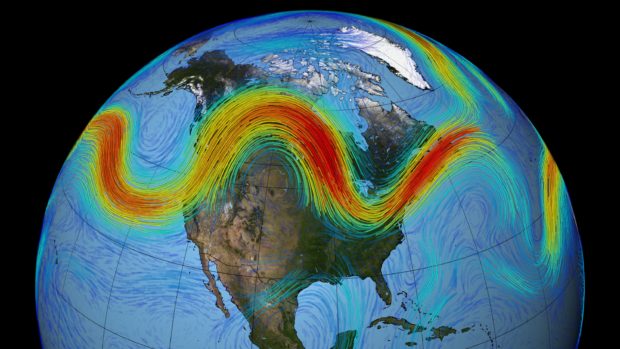
Extreme cold weather being caused by the jet stream is not a result of Arctic warming, research suggests.
Past studies have indicated the warming Arctic region causes a wavier jet stream – which can lead to the conditions caused by intense cold air striking the US and Europe.
However, the new study shows Arctic warming does not drive a more meandering jet stream.
Instead, the researchers from the University of Exeter believe any link is more likely to be a result of random fluctuations in the jet stream influencing Arctic temperatures, rather than the other way around.
Dr Russell Blackport, a research fellow in mathematics and lead author of the study, said: “While there does appear to be a link between a wavier jet stream and Arctic warming in year-to-year and decade-to-decade variability, there has not been a long-term increase in waviness in response to the rapidly warming Arctic.”
For about two decades, the jet stream – a powerful band of westerly winds – was observed to have a wavier flow, which coincided with greater Arctic warming through climate change.
These waves have caused extreme weather conditions to strike mainland Europe and the US, bringing intense cold air that leads to extreme cold weather.
In this new study, Dr Blackport and Professor James Screen studied not only climate model simulations but also the observed conditions going back 40 years.
They found that the previously reported trend towards a wavier circulation during autumn and winter has reversed in recent years, despite continued Arctic amplification.
This has resulted in no long-term trends in waviness, in agreement with climate model simulations, which also suggest little change in “waviness” in response to strong Arctic warming.
According to the study published in journal Science Advances, the observed and simulated link between jet stream waviness and Arctic temperatures do not represent a causal effect of Arctic amplification on the jet stream.
Professor Screen, an associate professor in climate science at Exeter, added: “The well-publicised idea that Arctic warming is leading to a wavier jet stream just does not hold up to scrutiny.
“With the benefit of 10 more years of data and model experiments, we find no evidence of long-term changes in waviness despite on-going Arctic warming.”

Enjoy the convenience of having The Sunday Post delivered as a digital ePaper straight to your smartphone, tablet or computer.
Subscribe for only £5.49 a month and enjoy all the benefits of the printed paper as a digital replica.
Subscribe